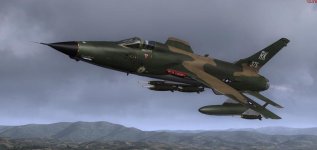A few comments on some of the posts above, and the F-105 in general:
1. 382 F-105Ds and F's were lost in South East Asia, 320 in combat and 62 in operational accidents in the course of over 20,000 sorties in SEA, representing a loss rate of 1 aircraft every 62.5 sorties.
That sounds like a lot and it was, but you have to consider that until the 1968 bombing halt, the F-105s were flying a very high percentage of missions over Route Packs 5 and 6A - the most heavily defended airspace in history. After the bombing halt the Thuds were more often than not flying over Laos bombing very heavily defended sections of the ** Chi Minh trail, so their level of risk was very high as well.
This risk was also made far worse, by micromanagement of the air war over North Vietnam, including dictating predictable routes, times and flight altitudes by bureaucrats in the Pentagon and state department, something that made it far easier for the North Vietnamese to down F-105s.
2. The F-105 losses compare to 445 F-4s lost in total,including 382 in combat. The F-4 did not become the USAF's principal ground attack aircraft in SEA until after the F-105Ds and F-100Cs and Ds went home in 1970-1971.
3. The F-105s flew twice as many sorties over North Vietnam than any other aircraft type, however, by 1970, the loss of 382 aircraft our of only 610 F-105Ds and a handful of F-105 F/G aircraft meant that the F-105 was getting hard to support in the field due to the dwindling numbers.
However, it's not accurate to imply that the F-105 was pulled out of combat due to the high loss rate or the inability of the aircraft to handle the mission.
The fact was that nothing was faster on the deck than the F-105 and it was very well suited to the conventional air to ground fighter bomber role, despite it's origins as a high level nuclear bomber.
4. The F-105 scored 27.5 kills against MiGs in SEA, 3 of them with AIM 9s and the rest with the 20mm cannon. This compares to 17 losses due to MiGs in SEA.
The F-105 didn't turn well, due to the same high wing loading that gave it excellent capability in high speed, low level flight, but it was fast and it accelerated well, giving it the ability to determine when the fight started and ended.
5. A number of F-105Fs were modified with all weather radar and bombing capability under the Commando Nail project and these became the genesis of the F-105G Wild Weasel III aircraft.
The F-105G actually replaced the unsuccessful F-4C Wild Weasel II, and the earlier F-100F Wild Weasel I aircraft. (The US Navy's counterpart to the Wild Weasels were the modified Iron Hand A-4E Skyhawk and A-6B Intruder).
The F-100F was replaced as it didn't have the range at high speed and low level to enable it to loiter in the target area long enough to cover a strike from start to finish.
The first effort to convert the F-4C to the Wild Weasel role was not successful, but eventually the attrition in the F-105 F/G aircraft forced the USAF to revisit the concept and this resulted in the F-4C Wild Weasel IV, and eventually in the F-4G Wild Weasel V, converted from F-4E airframes.
All of the above aircraft, with the exception of the A-4E Skyhawks, were two seat aircraft. It was however not uncommon to pair a Wild Weasel F-105G with a single seat F-105D to put iron bombs on a SAM site after the F-105G took out or forced the shut down of the SAM site's radar.





